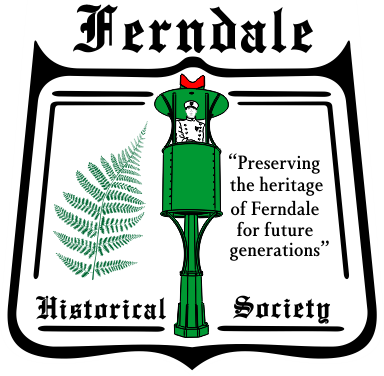Despite the efforts of many in Ferndale, a tragic air crash in 1946 has been all but forgotten, again. On what would have been the 100th birthday of the Ferndale Pilot, and 30th anniversary of the event memorial, let's look at those chilling events.
The Pilots
Judson Neff Berger (Jud) was born in Lima Ohio on Oct 14, 1924. He and his family lived at 782 West Oakridge in Ferndale. He was a popular student in Ferndale schools graduating in the June 1942 Lincoln High School Class. He was active on the baseball team, basketball team, and class Vice President. He attended Michigan State College in Lansing for two semesters.
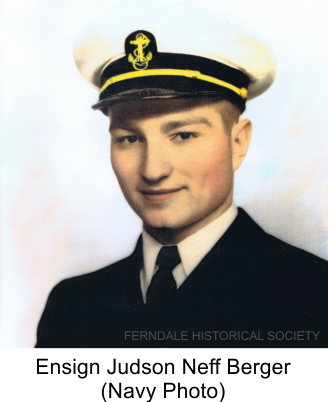
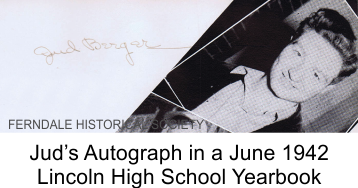
He entered the Navy on August 30, 1943 and was roommates with Orlo Frederick Hall (a resident of Detroit), at Ohio Wesleyan pre-flight school and at Mount Pleasant flight school. Berger received his commission on April 4, 1945 at Corpus Christi and was placed on active reserve on November 29th. He was working to fulfill his flight orders which were written for February 10, 1946 through March 17, 1946.
On March 17, 1946, Jud and four other Pilots dropped by the Naval Air Station on Grosse Ile to sign out 3 aircraft. The aircraft were SNJ-5 advanced trainers as pictured below. Judson and Orlo had hundreds of flight hours under their belt, but required many more. Jud had flown in the morning while Orlo was noted to be flying that afternoon and during the crash.
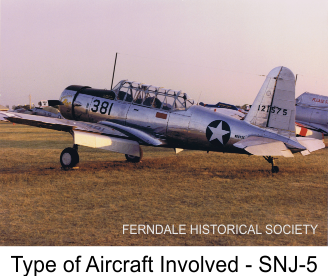
The Event
Sunday afternoon March 17, 1946 the SNJ-5 was flying over Ferndale when it went into a spin and crashed in what was then called Catalpa Park (later Roosevelt and now Geary Park). The aircraft was traveling at an estimated 100 MPH when it tore through power lines, bounced about 150 feet, and came to rest behind 2024 Central Avenue (since demolished). The resident at the time, Lloyd C. Humphries, was sitting in his living room reading the paper when the crash occurred. The engine of the aircraft was smoldering, but there was no fire. He called the Ferndale Fire Department who quickly arrived to rope-off the site from spectators and souvenir hunters. Later witness accounts admitted to taking souvenirs.
Orlo Frederick Hall was in the forward seat and believed to have been piloting the aircraft. Judson N. Berger was in the aft seat, which was also equipped to pilot the aircraft, but reports show he was a passenger. Navy officials believe Berger had attempted to bail out before the crash. However, his opened parachute had caught on the cockpit cowling throwing his body clear of the wreckage. When the Fire Department arrived they used remains of the parachute to cover the tragic scene.
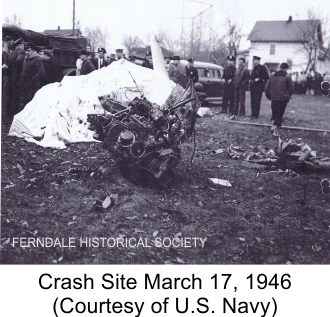
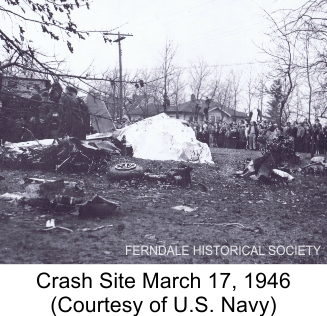
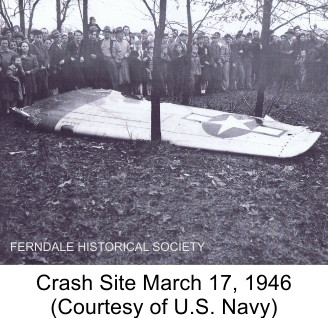

Funeral services for Judson were held at the Hamilton Funeral Home in Detroit with Reverend H. Paul Sloan of the Drayton Avenue Presbyterian Church officiating. Burial was in Lima Ohio


The Tragic Scene
Witnesses working at their homes and children playing in the park that Sunday afternoon described terrifying scenes. Some saw the plane go into a spin at about 500 feet, pull into a glide and attempt to land when it struck the power lines. During the Navy's investigation they gathered some official witness statements:
George H. Tweney Professor of Aeronautical Engineering at U of D and Ferndale resident: “I was working in the garden (about 2 ½ blocks south of the location of the crash) at approximately four o'clock in the afternoon and observed two planes circling at a low altitude. The aircraft at the lower altitude buzzed its engine and then started a steep right climbing turn. It seemed to have low air speed at the top and fell to the right. The plane seemed to be too low for recovery and the actual impact was blanked out by a house. When last observed it was diving rapidly, with tail high, nose down. The right wing was down and the aircraft was making a diving turn to the right. I arrived at the scene of the accident immediately. Plane number 2 was neglected upon crash of the first aircraft. Aircraft number 2 was almost as low as the first aircraft, possibly 200-300 feet. I could not observe any identification.”
James D. Campbell US Navy Retired : “At about 4:05 p.m. on Sunday March 17, 1946, I was driving South on Woodward Avenue between Ten Mile road and Lincoln Avenue. I noticed an airplane at about 500 feet altitude due South of me. He appeared to be in a gentle right turn when he reversed his direction as if making a dive bombing run. He had not recovered from the dive when he went behind the trees. It took me about 5 minutes to find the crash, and when I arrived, the police had arrived as well as the Ferndale Fire Department Rescue Squad. At the time of the crash there was a second SNJ in the air near the scene but left immediately following the crash.”
E.D. Anderson, Operations Officer at U.S. Naval Air Station Grosse Ile Mi: “To whom it may concern. The Operations Officer arrived at the scene of the accident at 1655 and ascertained the following facts: The police department of Ferndale arrived at 1546 and covered the forward portion of the fuselage with a parachute. They also maintained guard until relieved by station personnel. The fire department of Ferndale arrived at 1547 and stood by until the arrival of station crash and rescue equipment. Station crash and rescue equipment arrived at 1815. No investigation could be made of the aircraft because of its demolished condition. No engine or control settings could be obtained. The gasoline selector switch was turned to the “ON” position and the main tank was being used. Approximately 25-35 gallons of fuel remained in the main tank.”
Patrick T. Sullivan: In a January 31, 1994 Royal Oak Tribune article, then Councilman Sullivan vividly recalls these memories: “I wasn't there when the plane went down, but shortly afterwards". A lasting memory about the crash site was seeing a wheel of the plane “down the block, up on somebody's porch.”
By the next day the story was shared in local papers and worldwide. One story from the Melbourne Australia Argus used attention-grabbing tag lines as shown below.
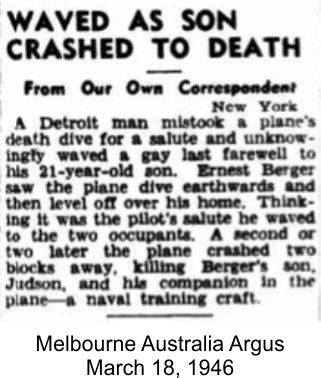
The Controversy
Newspaper editorials of the day, as well as efforts to memorialize the events in the 1990s, and social media chatter today often cast aspersions on the conduct of the pilots. As you will see later, it took years of dedication by two area veterans to gather the facts and set the record straight.
The naval investigation reports (on file at the museum) offer exceptional detail into the events of the day. The initial report from the Grosse Ile Naval Air Station on April 1, 1946 casts some doubt on the flight activities of the day. There were reports of low flying aircraft over Ferndale on the two Sundays prior to the crash. No aircraft identification was reported at the time so the pilots could not be identified, although the official report notes Orlo was among the group of suspect pilots.
As with all things military, the report had to go up the chain of command for review and concurrence. During the next review on May 7, 1946 the officials made it clear that: “cause of death was a crash during an attempted recovery from a stall out of a climbing turn, not in diving or acrobatic maneuvers”. The report definitively declares that neither the pilot or passenger died as a result of misconduct and in fact died in the line of duty. In May 1946 the Chief of Naval Air Training concurred that the deaths of these two young men occurred in the line of duty. By June 19, 1946 the Judge Advocate General (JAG) also concurred. On September 12, 1950 a subsequent review by JAG held that the deaths had occurred in the line of duty and not as a result of their own misconduct.
Bringing the Story Back to life
A 1994 article in The Mirror written by Wright Wilson describes the long journey taken by two Ferndale veterans to remember the events of March 17, 1946:
“I walked away with tears in my eyes. It was all over. It was a sad day for their parents, it was a tragedy for the neighborhood.”
Retired Marine Colonel William Rodgers still has vivid memories of March 17, 1946. That was the day two local servicemen died in a plane crash, in what was then known as Catalpa Park, a few blocks from his home.
“Every time I drove or walked by that park I'd think of those guys dying, “ he says. But six years ago Rogers had a different vision. “I told my wife, somehow we've got to keep this history alive for Ferndale,” he says. “People in this city should know how they died and that they served their country. Let's see what we can do.”
The idea finally materializes this year, 48 years after Ensign Judson N. Berger and Ensign Orlo F. Hall perished while on a training mission. A memorial has been placed in the recently renamed Geary Park through the cooperation of local veterans and civic groups. The formal dedication takes place at 11 a.m. Friday, which is Veterans Day.
Rogers, an acquaintance of Berger from the old Lincoln High School, approached Ferndale City Council with the idea in 1988. He got approval with the condition that he provide documentation of the incident. He also asked the Parks & Recreation Advisory Board about using the location.
A member of the parks group, Frank Flores, took special interest in the project. Although Flores was born 2 years after the crash, he felt an obligation to help, having served in the Marines in the Vietnam War and in the Marine Reserve Unit for 18 additional years. He has also been POW/MIA chairperson for the American Legion Department of Michigan for the past three years.
Rogers and Flores researched the crash, but encountered some difficulty since Berger and Hall were stationed at a Naval Air Base on Grosse Ile which no longer exists. Authorities at nearby Selfridge Air National Guard Base could not provide details either.
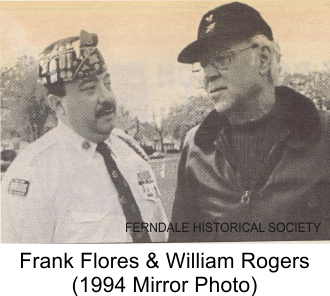
Through U.S. Rep Sander Levin, U.S. Naval Operations in Washington D.C. provided copies of official government reports and pictures, although it took a few years to produce the information.
Meanwhile, Flores used his connections with the Ferndale Historical Society to produce more facts and clippings about the crash. He plans to display stories and pictures at the dedication ceremony, and he hopes people who remember the crash will attend Friday's ceremony and tell him about their recollections. Flores would like to establish a permanent display about the crash at the Ferndale Historical Museum. “Being involved in it was an honor for me” he says. “It was great to put this little project together.”
Friday's ceremony also includes an honor guard, a wreath-laying, the Star Spangled Banner, and speakers. Representatives of Ferndale American Legion Post 330 and Veterans of Foreign Wars Post 1407 are expected to attend, as well as federal, state, county, and city officials. Flores said he has also attempted to contact relatives of the two servicemen.
The centerpiece of the ceremony is the monument, an engraved plaque mounted on a 3-foot stone. “It's just what I wanted to put over there,” Rogers said. “It's something I wanted to leave for the kids and future residents of Ferndale, so they can know what happened in 1946.”
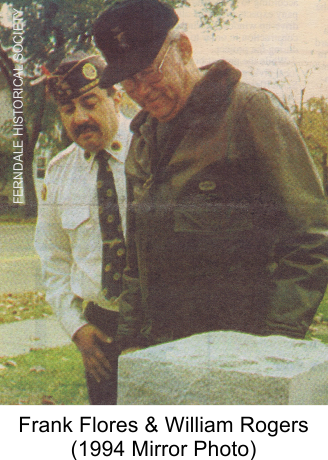
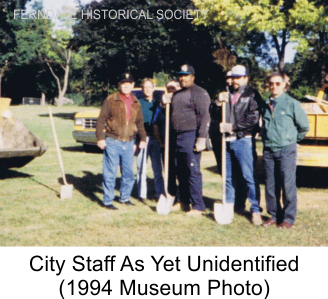
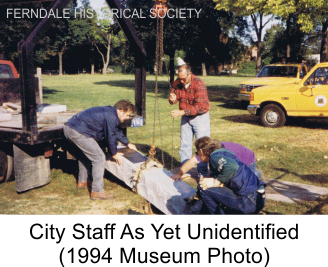
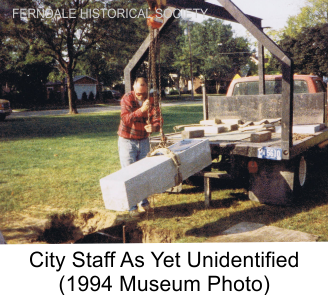
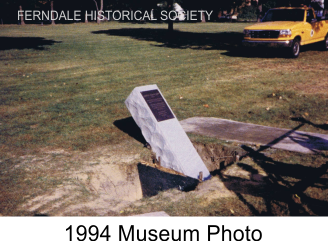

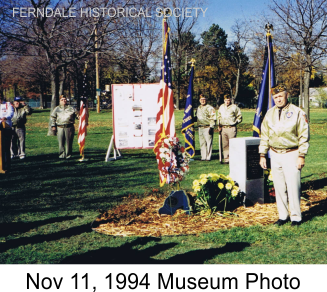
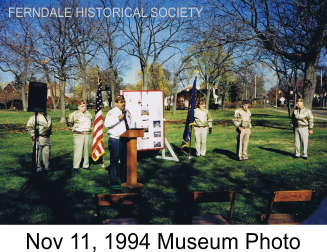
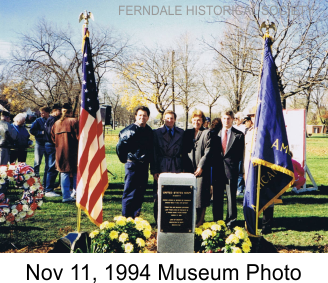
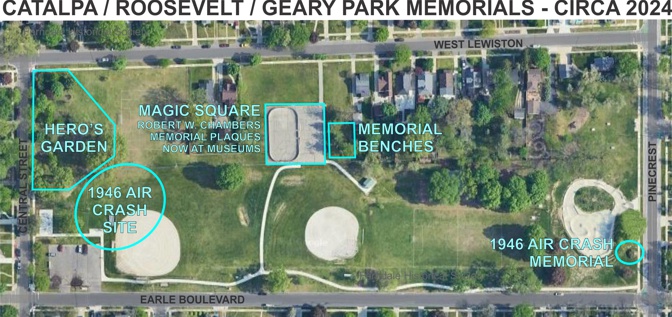
The Memorial
In March 1994 the artwork was approved for the plaque to be installed later that Summer. The memorial was placed in the Southeast corner of the park near Pinecrest and Earle Boulevard where it stands today. Over the years the garden and surrounding area have changed. But the monument still stands as a testament to the tragic loss. Few people today would know about this tragedy without the years of dedication and research by William, Frank, and many others.
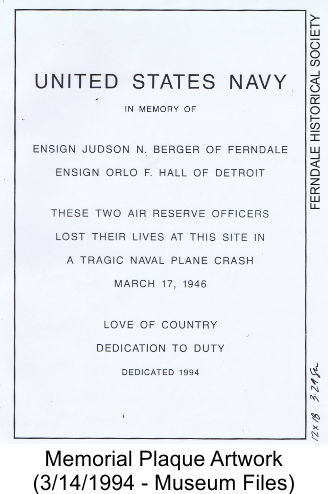
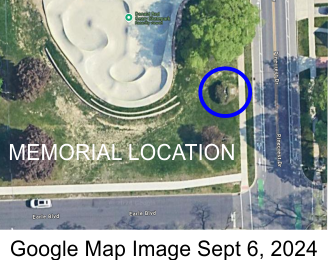
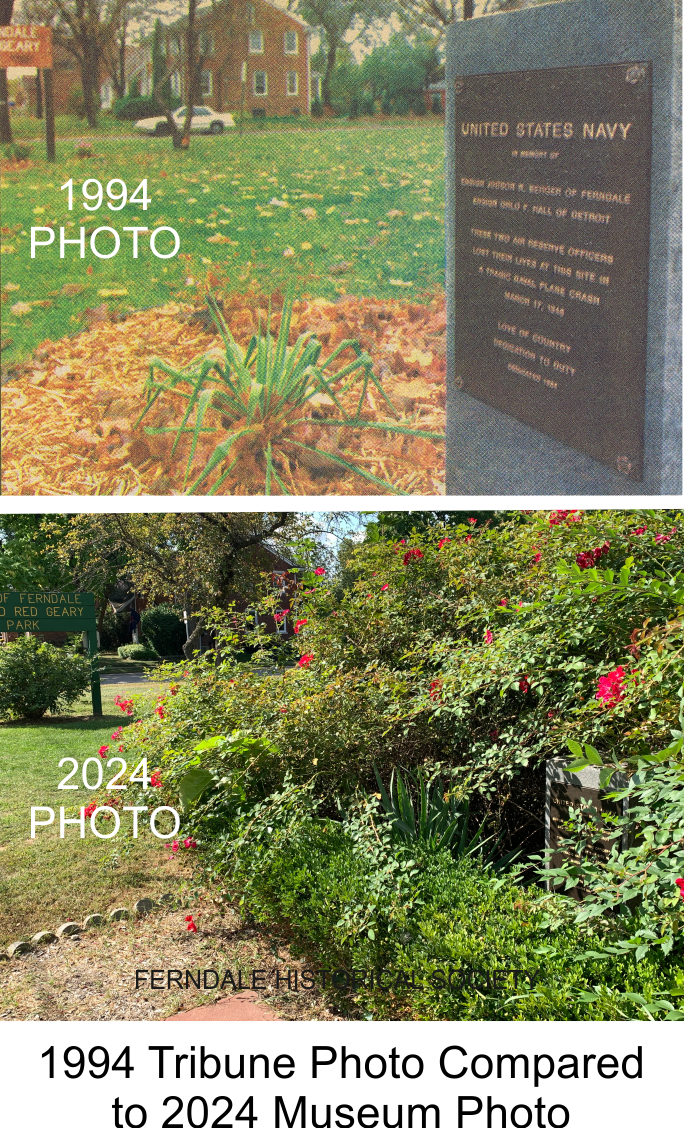


If you have photos, documents, or other material to contribute please contact the museum. Thank You

